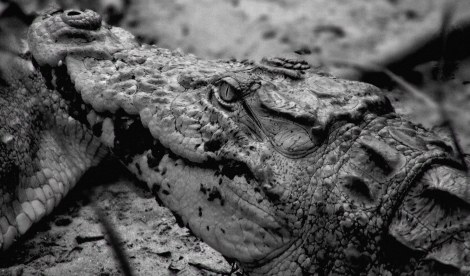This is my first try at wildlife photography and I thought why not to shoot the wildest of the reptiles, the wildest of beasts! CROCODILE. Well, I love its stare! Its a crocodile of about 7 years. I would love to have comments from you people about this photo and next series of photographs I’ll publish! Suggestions are welcome.
I thought why not to incorporate some facts about this majestic reptile.
- Crocodile skin is considered one of the finest and best, being soft and durable. In many tribal societies, skin crocodile is used as a symbol of high status. But only the skin on the belly has these qualities; the back skin is covered in bones (called osteoderms) that reflects arrows, spears and even bullets!
- Each crocodile jaw carries 24 sharp teeth meant to grasp and crush, not to chew. That’s why they swallow stones that grind the food inside their stomachs (the stomach stones also serve as ballast). The teeth are continuously replaced along the crocodile’s life. Crocodiles can exert enormous pressure when closing their jaws, but the force for opening them is so WEAK, that an adhesive band is enough to keep a large crocodiles’ jaw shut up. The powerful jaws can be extremely delicate, working like pencils, when removing offspring from the nest. Still, beware at the tail: it inflicts powerful blows.
- Many times crocodiles stay on the river banks mouth wide open. That is not an aggressive posture, but a way to cool off: they sweat through the mouth! Cool dudes!(My next photo will be a croc with an open mouth!)
- The crocodiles have a four-chambered heart like in birds (their closest relatives) and mammals, for an active life. Still, when diving, the heart behaves like a three-chambered reptilian heart, enabling them to stay more underwater.
- 99% of the crocodile offspring are eaten in the fist year of life by large fish, monitor lizards, herons and … adult crocodiles. During the first weeks of life, the crocodile offspring eats the food reserves from its viteline sack. The crocodile eggs are appreciated by monitor lizards, hyenas, large storks and even… humans. A female lays 20-80 eggs which are incubated in a nest built from plant materials and defended by her for three months.
- Crocodiles can swim just with the help of their powerful tail with 40 km (25 mi) per hour, and can stand underwater 2-3 hours. On land they can burst on short rapid races, but they get tired very quickly. They can also execute jumps out of the water, a several meters long.
And can you people recognize the difference between a crocodile and an alligator??
Take a look!
If you are not accustomed to their shape, look at the mouth: crocodiles have a clearly visible the fourth tooth on the lower jaw even when the mouth is closed (alligators and caymans have a groove where that tooth fits). Because crocodiles have salt glands inside their mouths they can stand sea water, while alligators cannot. That’s why many crocodiles species abound in mangroves and estuaries. Behaviorally, crocodiles are more active and more aggressive than alligators, and also less resistant to cold (alligators are found in subtropical areas, crocodiles not).
HAVE A NICE DAY!
CHEERS!

Pingback: Gruesome Look! | POTRAITURE·